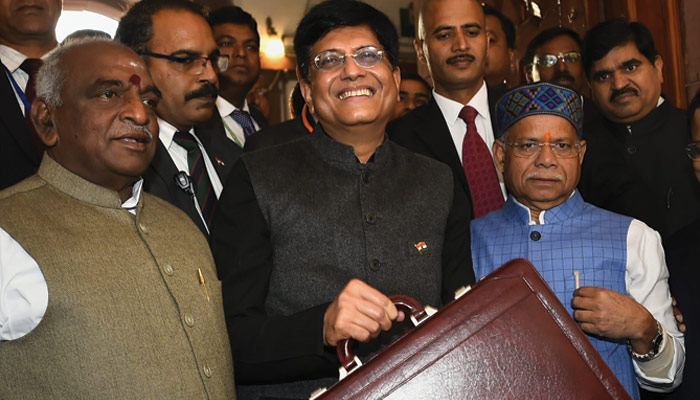Interim Finance Minister Piyush Goyal, in his nearly two hour long speech, has presented an election budget and not an interim budget as expected. He, however, has successfully appeased farmers, middle class and small businesses, the three major electoral constituents having strong resentment against the central government. He didn’t disappoint either. It was expected following a drubbing in the elections to the important heartland states of Rajasthan, Chhattisgarh and Madhya Pradesh. In the process, he has also prodded an ailing sector such as real estate to kick start growth. It was certainly a populist budget as the Prime Minister Narendra Modi himself said “Over 12 crore farmers, 3 crore salaried professionals and their families will gain thanks to #BudgetForNewIndia.”
Apart from the direct farmer’s package the FM announced Rs60000 crore for MGNREGA, and Rs50164 crore for Urea subsidy. The interim FM also laid out a 2030 vision for $10 trillion economy.
No doubt, the budget supports consumption by increasing enough disposable incomes of middle class families. Secondly, the taxation-linked sops given to this section will also result in some much needed push to consumption demand as it will increase discretionary spends, which will impact the auto sector.
The budget is good for FMCG firms as well as consumer durables companies.
Fiscal deficit
A sustained higher fiscal deficit gradually creates inflationary pressure in the economy. The fiscal deficit touched a high of 5.8% in 2011-12 because of the fiscal stimulus post the global financial meltdown. The fiscal deficit figure was 4.1% in 2014-15, 3.9% in 2015-16, 3.5% in 2016-17, 3.2% in 2017-18 and 3.4% in 2018-19. The government has already missed the fiscal deficit target of 3.3% in 2018-19 which has slipped to 3.4%. This is certainly not comfortable figure for the foreign investors. Another bigger issue is of state fiscal deficits, which is on the rise because of farm loan waivers. According to the Moody’s Investors Service the government will find it difficult to meet the fiscal deficit target of 3.4% in 2019-20 on account on higher spending and low revenue growth. Deviating from the path laid down in the Fiscal Responsibility and Budget Management (FRBM) Act, the government has pegged the fiscal deficit for the next financial year at 3.4% of GDP, as against the original target of 3.1%.
Capital gains on a second residential house
To prop up the ailing real estate sector FM has announced roll over capital gains on a second residential house (in buying another house). This will attract more investors to buy second homes. There are estimated seven lakh unsold units across the top cities.
For Small businesses
FM has also considered the problems faced by MSMEs hurt by the blows of Demonetization and GST implementation. Now all GST registered SMEs will get a 2% interest subvention on loans higher than Rsone crore. Secondly, all government firms have been mandated to source 25% of their requirements from SMEs. Of that, at least 3% should be sourced from SMEs owned by women entrepreneurs. Giving in to SMEs’ demand, nearly 90% of GST payers will now be allowed to file quarterly return soon, instead of monthly return.
For Farmers
Relief for the farming community is in the form of a direct benefit transfer. A new scheme Pradhan Mantri Kisan Samman Nidhi will be launched. Under this scheme Rs6,000 will be transferred to every farmer owning 2 hectares. Under the scheme, there will be a direct benefit transfer of Rs6,000 crore annually. This will be given in three equal installments of Rs2,000 each.
Key Budget highlights are:
- Expenditure: The government proposes to spend Rs27,84,200 crore in 2019-20, which is 13.3% above the revised estimate of 2018-19.
- Receipts: The receipts (other than net borrowings) are expected to increase by 14.1% to Rs20,80,201 crore, owing to higher estimated revenue from the goods and services tax and income tax.
- GDP growth: The government has assumed a nominal GDP growth rate of 11.5% (i.e., real growth plus inflation) in 2019-20. The nominal growth estimate for 2018-19 was 11.5%.
- Deficits: Revenue deficit and fiscal deficit are targeted at 2.2% and 3.4% of GDP respectively, same as the revised estimates for 2018-19. The government is estimated to breach its budgeted target for fiscal deficit (3.3%) in 2018-19 and the medium-term target of 3.1% in 2019-20.
- Ministry allocations: Among the 13 highest allocations to ministries, the highest percentage increase is observed in the Ministry of Agriculture and Family Welfare (78.1%), followed by Ministry of Petroleum and Natural Gas (32.1%) and Ministry of Railways (21.1%).
Some changes made to the Finance Bill include:
The Finance Bill amends the Income Tax Act, the Indian Stamp Act, and the Prevention of Money-Laundering Act.
Income Tax Act, 1961
- Rates: The income tax rates remain unchanged. However, the surcharge on income tax has been raised from 3% to 4%.
- Deductions: For salaried individuals, standard tax deduction has been increased from Rs40,000 to Rs50,000. Also, individuals earning an annual income of up to five lakh rupees will not have to pay any tax.
- Housing: Currently, there is no presumptive rent on one self-occupied house. Interest on housing loan is deductible for one house. On sale of a house, capital gains deduction is available if the gains are invested in buying a house. For all these, the limit has been extended to two houses (capital gains benefit limited to two crore rupees).
- Tax deducted at source: Exemption from TDS on rent has been increased from Rs1.8 lakh to Rs2.4 lakh per year. The threshold for TDS on interest on bank and post office deposits has been increased from Rs10,000 to Rs40,000.
- Incentives for affordable housing: Last year, tax incentive was provided for building affordable houses if the project was approved by March 2019. This deadline has been extended to March 2020.
- Indian Stamp Act, 1899: Stamp duty on instruments in relation to securities, such as debentures or shares, is payable by the person executing the instrument. The Act is being amended to state that for transactions on stock exchanges, or transfers by a depository, the stock exchange or depository shall be responsible for collecting this duty on behalf of the state government. Further, the rate of duty has been changed for some securities.
- Prevention of Money Laundering Act, 2002: The Act allows attachment of the property for 90 days during investigation. This period has been extended to 365 days. This period will not include any period during which the court has stayed the investigation.
Key Policy Highlights include:
- Agriculture: PM-KISAN is being launched under which Rs6,000 per year will be directly transferred to farmers with cultivable land up to 2 hectares. This will be paid in three instalments. The scheme starts from December 2018. Rs20,000 crore has been allocated in 2018-19 and Rs75,000 crore in 2019-20.
- Last year, the Kisan Credit Card scheme was extended to animal husbandry and fisheries. The 2% interest subvention and 3% incentive for prompt repayment, which are available to agriculture, are being extended to these two sectors.
- Farmers affected by natural calamities were provided interest subvention of 2% for one year. This is being extended to every year of the loan. In addition, a 3% incentive is being provided for timely repayment of the loan.
- Labour: The Pradhan Mantri Shram Yogi Maandhan will be launched to provide social security coverage to workers in the unorganised sector with a monthly income up to Rs15,000. A monthly pension of Rs3,000 will be provided from the age of 60 years. The monthly contribution of the worker will be matched by the Government.
- Entertainment: A single window clearance for shooting films, which was available only to foreigners, will be made available to Indian filmmakers. Further, the Cinematograph Act will be amended to introduce anti-piracy provisions.
Focused on the urgent need of the hour
By Sudip Bandyopadhyay
Despite the fact that it was a vote on account / interim budget, there were a number of interesting initiatives which were announced. Some of these, such as the tax relief for the middle class, augmenting agriculture sector incomes for small farmers, etc. will fuel consumption, while others, like, modifying tax provisions related to house purchases and rent, raising thresholds of certain categories of income that attract TDS, etc. were pragmatic. Most importantly, the budget seeks to achieve high growth while keeping the fiscal deficit and even inflation low.

Universal basic income which was being talked about for sometime got finally implemented in a manner for small and marginal farmers. While this may be the most significant development of this interim Budget, the compulsion for the Government facing a General Election in few months was clear. At this stage, probably they had very little choice post implementation of Rythu Bandhu and Kalia schemes by Telangana and Orissa governments respectively. In any case direct benefit transfer to affected small and marginal farmers is a much better way of handling farm sector distress compared to doling out farm loans waivers which completely distorts the culture and makes life even more difficult for the intended beneficiaries of such largesse i.e. small and marginal farmers. The question of course remains regarding source of permanent funding for such direct benefit transfer schemes in a sustainable manner as these kinds of scheme once introduced will be extremely difficult to withdraw. New Pension scheme launched for the unorganised sector employees can also be included in the above category. While these are socially desirable steps, funding for such endeavours need to be secured on a permanent basis.
The benefits passed on to lower income group through relief in Income Tax and also benefit for real estate owners are welcome and required corrective measures which will surely provide much needed relief to the harassed small tax payers. Since only around 1,00,000 taxpayers contribute 90% of Direct tax collection, in any case it is prudent to pass on these benefits to the vast tax base to make administration of Direct Tax simpler by focusing on a smaller and targeted universe.
Some tweaking of capital gains tax by providing relief through investment in residential properties and exemption from tax of unsold real estate inventory for two years are also welcome developments for this beleaguered real estate sector.
Over all the marginal slippage in fiscal target to 3.4% against the original 3.3% should not have significant adverse impact on the financial markets and investor sentiments. This fiscal deficit target also applies even for the next fiscal. The encouraging trend of growth in GST revenues and further streamlining of Direct and Indirect Tax may be in the forthcoming full Budget in June / July 2019, can address the issue of fiscal deficit and fiscal discipline in a more comprehensive manner.
Overall, it may be appropriate to conclude that this interim budget delivered in a calibrated manner what the urgent need of the hour was, both from the political and economic point of view particularly for the weaker sections of the society.






















